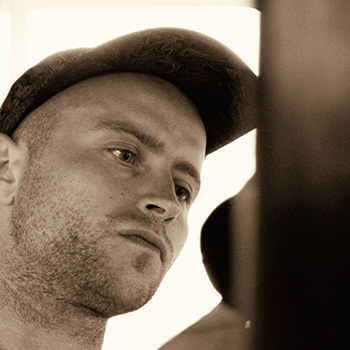
Tomás Rafa
When students learn about refugees in IWitness, it will be Tomás Rafa’s documentary video footage of the current-day refugee crisis in Europe that will help them make connections between refugees of the past and present.
Rafa is a visual artist, activist and filmmaker based in Poland. Among other projects, he is the creator of the “Walls of Sports” project, in which he and community members organize art workshops and paint murals on the concrete walls along the borders of Roma settlements in Slovakia. The aim of the project is to bring attention to the importance of dialogue and coexistence between the Roma minority and the majority population.
Producing his first video about Roma kids in 2009 inspired him to continue using his art to spark meaningful discussions about current events.
“I saw that artists could initiate social change,” Rafa said.
For the last few years he has devoted himself to documenting, through film and photography, the refugee crisis in eastern and central Europe. Beginning in 2015, Rafa began visiting the train stations, borders and refugee camps across Hungary, Greece, Croatia and Serbia where thousands of refugees, many from Syria, traveled on their way to western Europe, documenting their journey and the struggles they faced.
While USC Shoah Foundation international regional consultant in Czech Republic Martin Smŏk was working on a new IWitness “Connections Video” on refugees for the 100 Days to Inspire Respect program, he discovered Rafa’s footage on his website. Smŏk asked if he could include some of it in the educational video, and Rafa agreed.
The video introduces students to the concept of refugees and the experiences of refugees in modern history, from the Holocaust to the Cambodian Genocide. Understanding the reasons why people become refugees, and the conflicts that arise as they make their way across borders, can help students have empathy for refugees and survivors of today.
Along with archival video and photographs, the Connections video includes Rafa’s footage of the Iodemi refugee camp in Greece (March 2016), refugees in Opatovac along the Slovenian-Croatian border (October 2015), and the refugee camp in Roszke and Horgosz on the Serbian-Hungarian border the day it was closed (November 2015).
Rafa said what stuck with him the most from his time documenting the refugees was how different it was to be there in person versus watching media coverage, which is often biased, on TV.
“It was a big contrast between TV news with anti-refugee propaganda and real life. I saw mostly families with children, families from Syria, Afghanistan, Iraq,” he said. “I saw a lot of volunteers who helped give them water and food. These families were on their way for a couple of months from war zones, so they were suffering.”
He also noted that the volunteers acted as a buffer between the refugees and the police, which helped calm tense situations.
“At the boundaries there were police, army and refugees. Without volunteers there’s a lot of tension and big conflicts,” Rafa said. “With the police and patrols and army, there’s not so much humanity in these kinds of interactions.”
Ultimately, Rafa hopes his footage of the refugee crisis teaches students about what can happen when governments do not protect human rights.
“I think it’s an important message for Americans to see how far right populism propaganda could change social identity very quickly using racism and xenophobia,” he said. “I think this video could help show an American audience, and worldwide, the background of this crisis. There are suffering people and we should show our tolerance and our humanity, our solidarity for them.”
Photos courtesy Tomás Rafa